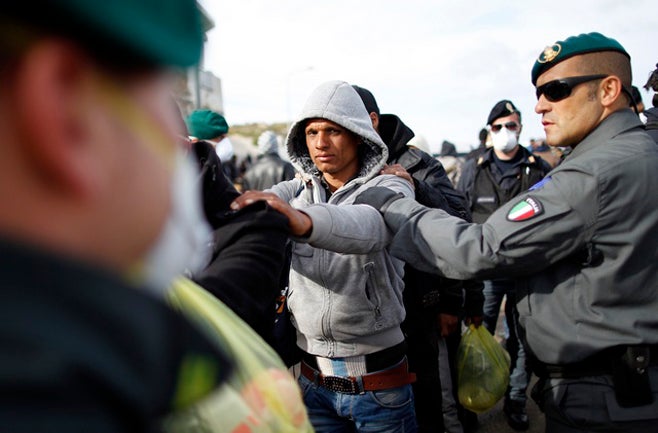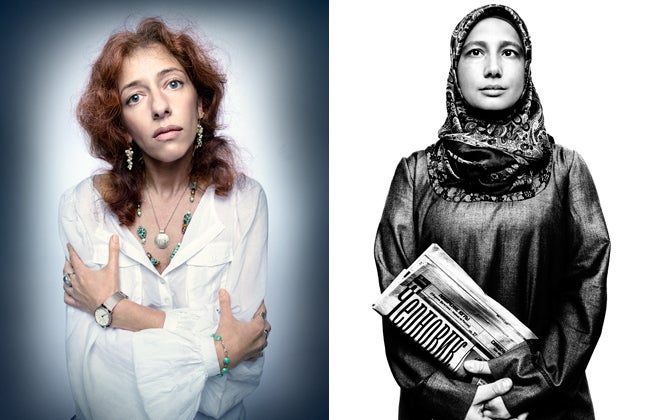Human rights violations increased significantly in Yemen in 2011, as authorities sought to quash largely peaceful demonstrations challenging the 33-year rule of President Ali Abdullah Saleh. State security forces, often acting together with armed plainclothes assailants, responded to anti-government protests with excessive and deadly force, killing at least 250 people and wounding more than 1,000.
Clashes on several fronts between government forces and various armed groups killed scores more civilians and displaced more than 100,000 others. State security forces, opposition tribal fighters, and Islamist militants may have committed laws of war violations during some of these confrontations.
Attacks on Protesters
In January, inspired by popular uprisings in Tunisia and Egypt, thousands of Yemenis began protests in major cities to force President Saleh’s resignation. Popular discontent, fueled by widespread unemployment and government corruption, soared in late 2010 after the ruling party proposed to amend electoral laws and the constitution so that Saleh could stand for re-election when his seventh term expires in 2013.
Security forces responded to the largely peaceful demonstrations with excessive force, often firing live ammunition directly at unarmed protesters. These forces include Central Security, a paramilitary unit commanded by President Saleh’s nephew, Yahya Saleh; the Republican Guard, an elite army unit led by the president’s son, Ahmed Saleh; and General Security. Central Security includes a counterterrorism unit that receives United States training, but Human Rights Watch was unable to verify allegations that the unit participated in the attacks on protests. The security forces sometimes attacked protesters together with armed assailants in civilian clothing, or stood by during attacks by armed gangs.
At least 250 civilians and bystanders died in these attacks, most in Sanaa, the capital, as well as in Taizz, and Aden. At least 35 of those killed were children. On March 18, snipers firing on a protest in Sanaa killed at least 45 people. Between May 29 and June 3, security forces killed at least 22 people in Taizz and razed a protest encampment. On September 18 and 19, Central Security and other government forces shot directly at rock-throwing protesters in Sanaa, killing about 30. In the following days security forces killed dozens more protesters and other civilians with gunfire, rocket-propelled grenades, and mortar rounds.
In Sanaa, Aden, and Taizz, security forces blocked wounded protesters’ access to medical care. They also raided and looted hospitals, and threatened, detained, or beat medical workers who sought to treat wounded protesters. In June Republican Guard forces began occupying al-Thawrah Hospital in Taizz and using it as a base to shell opposition neighborhoods. In September Central Security forces attacked opposition forces from Sanaa’s Jumhuri hospital. In November a government shell struck al-Rawdha Hospital, killing at least one patient.
A September report from the Office of the United Nations High Commissioner for Human Rights (OHCHR) found that elements “seeking to achieve or retain power” were “collectively punishing” the population by curtailing access to electricity, fuel, and water.
Authorities failed to prosecute any members of the security forces for serious human rights violations.
Armed Clashes
In May, after Saleh reneged for a third time on signing a Gulf Cooperation Council-brokered agreement to cede power, dozens of civilians were killed in fighting between government forces and various armed factions.
In May and June fighters of the opposition al-Ahmar clan skirmished with government forces in Sanaa. On June 3, an explosion in the mosque of the presidential palace in Sanaa killed 11 people, and gravely wounded Saleh and several high-ranking officials. Saleh spent three months in Saudi Arabia for medical treatment.
In mid-2011 government forces began fighting with tribal opposition fighters in Arhab, outside Sanaa, and in Taizz. In September Central Security and Republican Guards in Sanaa began clashes with fighters of the al-Ahmar clan and with soldiers from the First Armored Division, a military unit led by Gen. Ali Mohsen al-Ahmar—no relation to the al-Ahmar clan—who defected to the opposition in March.
During these armed confrontations there were credible reports of extrajudicial killings and indiscriminate attacks by security forces on densely populated areas. On June 22, at al-Buraihi checkpoint outside Taizz, a soldier of the Republican Guard fired on a minibus that his unit had just searched and authorized to proceed, killing a 15-year-old boy.
In May the government also launched a military campaign in Abyan province against Ansar al-Sharia (Partisans of Islamic Law), an armed group reportedly backed by Yemen-based al Qaeda in the Arabian Peninsula (AQAP). Ansar al-Sharia had previously captured two provincial cities, Zinjibar and Jaar. On May 20, Central Security forces opened fire with assault rifles in a crowded market in Zinjibar, killing six merchants and shoppers and wounding three dozen others. The forces opened fire after a car bomb nearby killed four members of Central Security, but there were no reports of militants or other suspects inside the market.
Witnesses said that opposition fighters repeatedly deployed in densely populated neighborhoods in Taizz, and that Islamist forces did the same in Abyan, potentially placing civilians at unnecessary risk of attack. Both government and opposition forces deployed children to patrol streets and guard checkpoints.
Freedom of Expression and Opinion
Government forces and armed gangs attacked, harassed, or threatened scores of Yemeni journalists and human rights activists, many for reporting on or denouncing attacks on protesters.
Two journalists were killed covering protests in Sanaa. Jamal al-Sharabi, a photojournalist for the independent weekly al-Masdar, was killed during the March 18 attack. Hassan al-Wadhaf of the Arabic Media Agency died five days after being hit in the face by sniper fire on September 19; he filmed his own shooting.
At a protest in Sanaa on February 18, men armed with sticks beat Al-Arabiya’s bureau chief, Hamoud Munasser, and his cameraman, then attacked his car in front of the director of Yemen’s US-funded Counterterrorism Unit and a Central Investigation Department official, both of whom failed to intervene.
Authorities expelled several foreign journalists and confiscated press runs of independent Yemeni print media, including Al-Yaqeen, that contained reports on security force attacks on Saleh’s opponents.
On May 25, pro-Saleh forces fired machineguns and mortar rounds at the satellite TV station Suhail, owned by the opposition al-Ahmar clan. On August 12, government forces arrested Ahmed Firas, a Suhail TV cameraman, as he left Arhab and confiscated his equipment. At this writing he remained detained without charge.
Authorities continued to prosecute journalists in specialized criminal courts that failed to meet international standards of due process. On January 18 the Specialized Criminal Court in Sanaa sentenced Abdulelah Haidar Shae’ of the state-run Saba New Agency to five years imprisonment after convicting him of membership of a terrorist group in a trial fraught with procedural irregularities. Shae’ had criticized government approaches to fighting al Qaeda.
Scores of human rights defenders were beaten or received frequent anonymous threats. In January some human rights defenders who were active in protests were briefly detained, including Tawakkol Karman of Women Journalists Without Chains and human rights lawyer Khaled al-Anisi. On February 24, five armed assailants repeatedly stabbed a guard at the Sanaa offices of the Yemen Observatory for Human Rights following anonymous threats against the group for releasing information on attacks on protestors.
Internally Displaced People
Armed clashes displaced about 100,000 people, mostly from Abyan to Aden. Approximately 300,000 had already been displaced during the intermittent six-year armed conflict in the north between government forces and Huthi rebels, who despite a ceasefire recaptured Sa’da governate in March. Up to 100,000 of these displaced people reportedly returned home. Aid agencies were unable to access many displaced people due to insecurity, inadequate funding, and a lack of government permission.
Terrorism and Counterterrorism
US officials in 2011 designated AQAP as a greater threat to its security than the core al Qaeda group in Pakistan.
AQAP claimed responsibility for placing bombs aboard two US-bound cargo planes in October 2010. The group also reportedly provided support to Ansar al-Sharia, the armed group that captured Jaar and Zinjibar in Abyan. Dozens of civilians were killed during clashes between government forces and Ansar al-Sharia in Abyan.
The US reportedly conducted more than a dozen drone strikes and piloted air attacks on alleged AQAP militants in Yemen, including one in September that killed the cleric Anwar al-Awlaki, and Samir Khan, editor of AQAP’s English-language magazine Inspire. Another suspected drone strike in October killed nine people including al-Awlaki’s 16-year-old son, Abderrahman. Both Awlakis and Samir were US citizens. US President Barack Obama called Awlaki the “leader of external operations” for AQAP, but the killing of three Americans outside a traditional battlefield heightened a controversy over the US targeted killing program.
Unnamed US and Yemeni officials said the drones and other air strikes killed dozens of militants. Local officials reported some civilian casualties but lack of access to the targeted areas prevented independent verification.
Campaign against Southern Separatists
Security forces targeted activists of the Southern Movement, an umbrella group seeking independence or greater autonomy for southern Yemen, a separate state until 1990. After the Southern Movement joined anti-Saleh protests in February, security forces briefly detained dozens of its members and forcibly disappeared at least eight of them for days or weeks. The eight who were “disappeared” included a leader of the Southern Movement, Hassan Baoum, 68, and his son Fawaz, 34. Masked security forces kidnapped the pair on February 20 from an Aden hospital where the elder Baoum was receiving medical treatment. They were held incommunicado until July and at this writing remained detained without charge.
In June soldiers in Aden killed Jiyab Ali Muhammad al-Saadi, 35, the son of a Southern Movement leader, when he asked them to stop blocking a burial procession for Ahmad al-Darwish, whom local activists alleged was tortured to death in police custody in 2010. Authorities transferred Aden’s Chief of General Security Abdullah Qairan to Taizz in March after a local court accused him in connection with al-Darwish’s death.
Women’s and Girls' Rights
Women in Yemen generally have low social status and are excluded from public life.
Child marriages and forced marriages remain widespread, exposing young girls to domestic violence and maternal mortality and truncating their education. Judges are not obliged to ensure a girl’s free consent before notarizing a marriage contract. In August a 12-year-old bride from Hudeida was reportedly injured after being drugged and raped by her 50-year-old husband. Despite such cases, conservatives have stalled a draft law that would set the minimum age for marriage at 17.
Women played an important role in anti-Saleh protests, despite beatings, harassment, and, in some cases, shame from relatives. In April Saleh admonished women demonstrators, saying “divine law does not allow” public intermingling of the sexes. Women responded with further protests. Karman was named a co-recipient of the Nobel Peace Prize in October for her role in the protests.
Yemen has a high maternal mortality rate of 370 deaths per 100,000 live births. Approximately seven to eight women die each day from childbirth complications.
Key International Actors
Saudi Arabia, Qatar, and other Gulf states provided substantial assistance to the Yemen government, tribal leaders, and religious institutions. The US was the largest donor outside the region. European Union states also provided humanitarian and development aid.
A Gulf Cooperation Council initiative, supported by the UN Security Council, offered immunity to Saleh and top officials in return for Saleh relinquishing power.
By May most Western and Gulf states had withdrawn public support for Saleh and informally suspended military assistance and arms sales, but ignored calls to freeze the president’s assets abroad. The US delayed counterterrorism assistance to Yemen because of political unrest after providing an estimated US$172 million in fiscal year 2010.
In September the UN Human Rights Council condemned human rights violations in Yemen, but failed to authorize an international, independent investigation into them or to establish an OHCHR field office in the country, despite calls for these actions from the OHCHR.
In October, for the second consecutive year, President Obama issued a waiver allowing Yemen to receive military assistance prohibited by the Child Soldiers Prevention Act of 2008, despite documented use of child soldiers by government forces and militias allied to the government.






